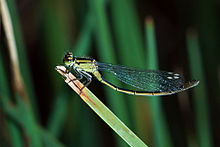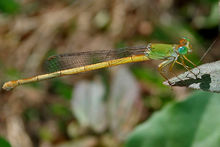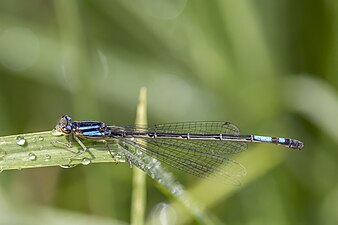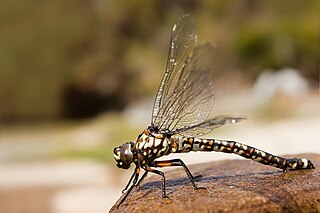
Aeshnidae, also called aeshnids, hawkers, or darners, is a family of dragonflies, found nearly worldwide, with more than 50 genera and over 450 species.

Rhionaeschna is the scientific name of a genus of dragonflies from the family Aeshnidae. They are also known as blue-eyed darners.

The Platycnemididae are a family of damselflies. They are known commonly as white-legged damselflies. There are over 400 species native to the Old World. The family is divided into several subfamilies.

Agriocnemis is a genus of damselfly in the family Coenagrionidae. Agriocnemis is distributed widely across Africa, South-east Asia, Indonesia, Australia and islands in the Pacific. They are small insects, commonly known as wisps.

Ceriagrion is a genus of damselfly in the family Coenagrionidae. Species of Ceriagrion are small to medium size, generally brightly coloured damselflies. They are found across the Old World, Africa, Asia and Australia.

Coenagrion is a genus of damselflies in the family Coenagrionidae, commonly called the Eurasian Bluets. Species of Coenagrion are generally medium-sized, brightly coloured damselflies.

Heteragrion is a genus of damselflies in the family Heteragrionidae.
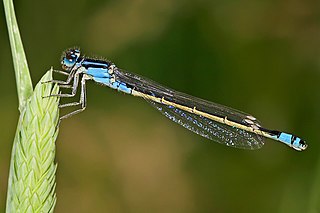
Ischnura is a genus of damselflies known as forktails in the family Coenagrionidae. Forktails are distributed worldwide, including various oceanic islands. The males have a forked projection at the tip of the abdomen which gives the group their common name.
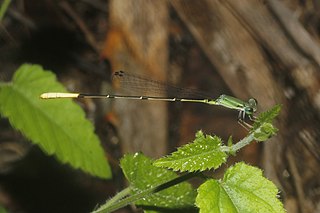
Leptobasis is a small genus of damselflies in the family Coenagrionidae. They are commonly known as swampdamsels. The genus is neotropical and one species, L. melinogaster, has been recorded in Texas. They are slender and the females have very long ovipositors.
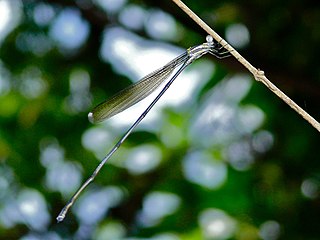
Mecistogaster is a genus of large Neotropical damselflies in the family Coenagrionidae, commonly known as helicopter damsels. There are eleven species distributed from Mexico to Argentina.

Neoneura is a genus of damselfly in the threadtail family Coenagrionidae. They are found in the Neotropics, from Cuba and Texas to Argentina.
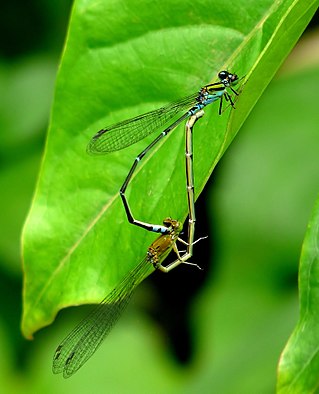
Pseudagrion is the largest genus of damselfly in the family Coenagrionidae, with over 140 species. Its range includes most of Africa, much of Asia, and Australia. Africa holds most of the diversity with almost 100 species. It has occupied most of the freshwater habitats in its range, and dominates damselfly communities in habitats as different as desert pools, equatorial rainforests and montane streams.

Tramea is a genus of dragonflies in the family Libellulidae, the skimmers and perchers. Species of Tramea are found in tropical and subtropical regions around the globe. They typically have colored bases to their otherwise translucent hindwings. In particular when they fly, this creates the impression of their carrying bags at the start of their abdomens. They are known commonly as saddlebags or saddlebags gliders.
Protoneuridae was formerly considered a family of damselflies. Recent taxonomic revisions have classified the species previously placed in Protoneuridae into two existing families - Coenagrionidae and Platycnemididae, both in the superfamily Coenagrionoidea.

Coenagrionoidea is a superfamily of closed wing damselflies of the order Odonata found worldwide.
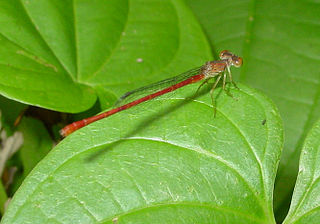
Telebasis is a genus of damselflies in the family Coenagrionidae. The genus occurs in the Neotropics. Most of the species are red with a few blue species in South America.
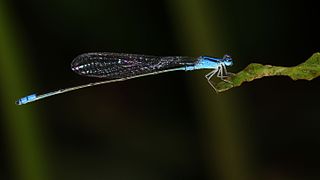
Archibasis is a genus of damselflies belonging to the family Coenagrionidae. These damselflies are generally medium-sized with bright colouring. Archibasis occurs in southern Asia, Indonesia, New Guinea and Australia.

Calopterygoidea is a superfamily of damselflies in the order Odonata.


